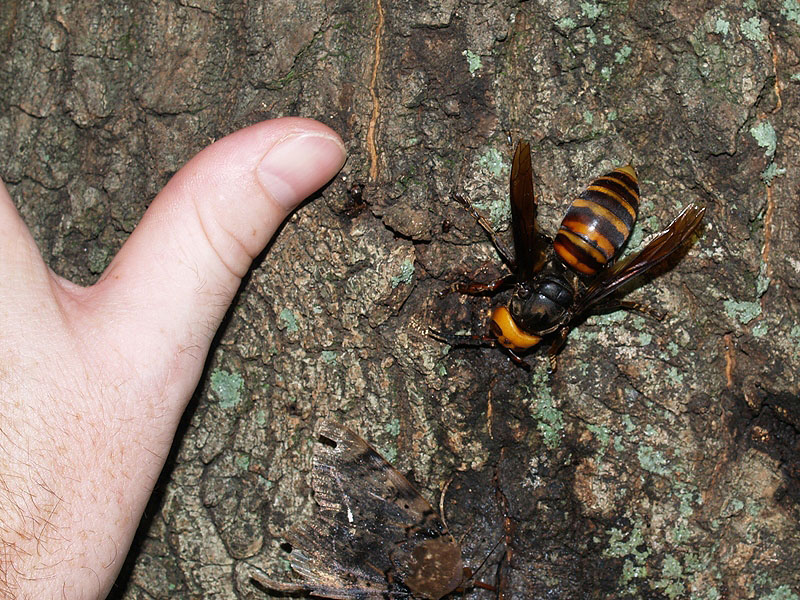Adaptation
The Asian giant hornet, or as it is
more commonly known in some cases the Japanese giant hornet, is
a very large winged insect near the size of a thumb, with an
average flight range of 1-2 km, and in the most extreme cases 8
km a day (Matsuura and Sakagami 1973). Additionally it appears
that not only are the Vespa mandarinia capable of far
distance flight, they are also capable of remembering pathways and
landmarks, using them to navigate. They can use landmarks to
guide their path to prior feeding areas or nests, even ignoring
feeders placed directly by their nest to fly to one that they
had been "trained" to use. They also controlled their altitude
in response to how far they would have to fly, and before
leaving would orient towards the feeder site, clearly showing
some type of memory because they would do this irregardless of
whether or not they could see the feeder site. What further
helps in indicating some type of memory, is that each hornet
would take an individual path, which may incorporate different
landmarks and they will correct their path as they go. It also
appears as if they can learn a new path if the feeder is
removed, altering their paths after a couple of visits to get to
the new feeder. More amazingly, even when they are
impaired with antenna damage, they can navigate to the site,
only being unable to even fly when part of their eyes were
covered and vision was impaired, implying that chemical cues are
not exclusively used to navigate to the food site. V. mandarinia was also
found to navigate in the dark, perhaps using a combination of
visual and chemical cues, combined with its path memory (Toh and
Okamura 2003).

They are the largest of the Vespa family; with a “deeply
incised clypeus and enormously developed genae” further
separating its body plan from the other members of the family
Vespa. The V. mandarinia, like all insects, are composed
of three body parts, six legs, and is covered in a chitinous
exoskeleton. Its massive size also means it has a massive
stinger, with very dangerous venom that can cause severe damage
to anything afflicted by it, as seen on the venom page. The
exoskeleton is also of particular note, as it is nearly impervious
to bee stings which Japanese honey bees have developed a unique
defense to, and which
European honey bees have not. The clypeus
is the section on an insects face below the eyes and above the
mandibles, a hard part visibly separate from the rest of the
face, while the genae are the “cheeks” of an insect, lying on
either side of the head, and supporting its powerful mandibles.
The genae size factors into the head size, which in addition to
weight, eye width, and head width allows it to outclass other
members of the family, with the nearest specimen,
V. tropica,
weighing in at .42 grams less than V. mandarinia,
which is a sizable 1.60 grams (Matsuura and Sakagami 1973).

The queens can grow even larger, specifically when new queens
are preparing to leave a nest; this results in a weight change
from 2.9 grams to 3.5 grams. They build primarily subterranean
nests in hollows or prior rodent dwellings, and live there for
the entire nesting season. As for feeding, the V. mandarinia can eat sap or they can prey upon insects that
are not agile enough to escape their large forms, such as
caterpillars and spiders. Another more extreme method of finding
food is when a group of up to 50 giant hornets
attack in a
coordinated fashion on a
bee nest, or even another wasp nest,
seen
here,
which is considered to be possible chemical signal activation
via a scout hornet that allows its fellows to find it and join
the attack (Toh and Okamura 2003). The attack occurs in three phases: hunting,
slaughter, and occupation. This attack can stretch across days
or it can last a mere matter of hours, and by the end the
colonies inhabitants are dead or have ran away, leaving the
larvae and pupae ripe for the taking, which the giant hornets
take back to their nest. They will also gather up “meat balls”
of mesosomas and take them back to the nest for later
consumption by the young. Generally for these nest attacks they will stay
within their 1-2 km average for nest distance (Matsuura and
Sakagami 1973). When going into sap feeding patches,
V. mandarinia is shown to defeat all other sap feeding
species a majority of the time, should fights occur.

The giant
hornets will even warn off butterflies and other Vespa
should it want the patch to itself through sheer threat of its
intimidating presence. The butterflies are always unwilling to
fight but will often fly to the patch without realizing the
danger, the exact opposite reaction of other members of the Vespa. As it
is the world’s largest hornet and is also additionally very
aggressive, this means that it generally has a patch under its
control, with a 98% victory rate in the event of fights. However
it also seems as if visual avoidance cues may also play a role
in sap interactions among Vespa, preventing possible
conflicts in certain cases (Yoshimoto and Nishida 2009)
Habitat
Venom
Home Page
References